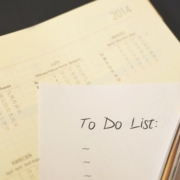Copywriting do’s and don’ts (Pt I – the do’s)
Sometimes the things you see in print just make you cringe! How did the copywriter get away with that? What were they thinking.
So here’s part one of ‘Copywriting do’s and don’ts’. Let’s start with some things you’ve just got to do.
Table of Contents
1. Do: check your copy
It’s so easy to get a bit carried away when you’re writing copy. You’ve written some pretty neat lines and the copy seems to hang together well. But you’ve got to step back at the end of every job and think: Have I missed anything? Check it meets the requirements of the brief completely. Check if there were any ‘mandatory’ things specified that you might have forgotten to include (for example “Copy must refer to client’s European heritage” or something like that).
And for goodness sake check your spelling! There’s nothing that says “shoddy” more than copy with spelling mistakes. Get in the habit of using the spell check on your computer but don’t depend on it totally because it will miss things. You’ve got to go through your copy line by line, word by word and make sure it’s all correct.
That’s easier said than done because you will be very close to it and your eye often sees what it wants to see rather than what’s actually there. And double check the client’s name or the spelling of the product you’re selling as these won’t be done by the spell checker (it’s amazing how many times you see ‘Phillips’ instead of ‘Philips’). Getting this wrong is the quickest way to wave goodbye to a client.
2. Do: read a lot
If you love writing the chances are you love reading too. But when you do read, try and think about what the author is doing. Remember, you’re a creative writer just as much as any novelist and we’re all practising the same trade of getting people to think and feel how we want them to. It doesn’t really matter what you read because you can learn as much from good stuff as from bad stuff.
And it’s not just literature we’re talking about here. Keep up with magazines, newspapers and online as they all have their own ways of doing things that you need to be aware of. Not only that but very often it’ll be handy to be ‘in the know’ about latest developments whether in popular culture, current affairs or technology even.
This is particularly true if you’re writing for business to business clients: you should check the trade press regularly to know what’s going on in a particular industry. It helps make your copy more authoritative and will certainly impress your client in presentations when you can demonstrate that you really know what you’re talking about.
3. Do: keep an eye on your clients’ competitors
Before you sit down to write copy for your client it pays to check out what their competitors are doing first. For one thing you’ve got to be darn sure that any ideas you come up with haven’t been done by a competitor already.
More to the point, you need to know what the opposition are saying in order to come up with a substantially different proposition to differentiate your client from the rest. It’s not just the proposition that should be different either. You should be working on a distinctive tone of voice that fits your brand.
4. Do: think about who’s going to be reading your copy
One of the most important skills of a copywriter is to get the tone of voice right. This covers a lot of things like the words you use, the length of sentences or the use of imperatives and questions. And it depends on many other factors such as the type of product you’re advertising, where you’re advertising it and, above all, who you’re talking to.
It’s not rocket science though. Think about how you interact with people every day: you adopt different tones of voice when you talk to your mates, your bosses or teachers, your mum or grandmother, a policeman… we change our language and tone for each one without thinking. It’s much the same with ads. If you’re selling Playstations to youngsters you’re going to talk differently to when selling mortgage services to housebuyers. Use the language you’d expect your target audience to use but without ‘getting down with the kids’ on the one hand or writing something that sounds more like the terms and conditions than an ad on the other.
The trick is to imagine yourself face to face with your reader and write your copy as though it was a conversation. And remember too that your reader probably has better things to do with their time than be reading copy so keep things short and to the point. Get their attention, make your offer and give them a call to action they can’t resist.
5. Do: make a plan before you start writing
Whether it’s a 30 word ad or a 3000 word brochure before you start writing make sure you have a plan. It’s not just for the sake of clarity in your copy but it’ll help you marshal your ideas and get them in a logical sequence. Believe me, spending an hour or two on a plan at the beginning could save you hours and hours later on when you find your copy’s all over the place.
A professional advertising copywriter has many secret formulas to help structure a piece of advertising copy. Probably the most famous is “AIDA” which stands for Attention, Interest, Desire, Action. First, attract the reader’s attention: make a connection with them by identifying something they need. Next, arouse their interest, perhaps by suggesting that this need of theirs can be met by your Product X. Then sell it to them , tell them all the benefits it could bring, make them desire it! Last and most important tell them what to do to get their hands on it (and probably to do it fast!). Although AIDA was developed first for advertising its principles are just as applicable to most other media be they brochures or even TV commercials.
6. Do: read to write
This kind of follows on from the whole idea of planning but it’s worth thinking about in its own right. When you start a job you’ll (hopefully) get inundated with stuff to read. Not just the brief but background info, competitor info, previous jobs and so on. Make sure you spend time going through all of this. You’ll find that as you’re reading you’ll also be writing the piece in your head at the same time. So when you actually come to putting pen to paper or finger to keyboard the writing should virtually write itself.
What do you think? What things do you reckon every copywriter should do? Leave us a quick comment below. Alternatively, hire a freelance copywriter who can help you produce the best copy for your company.








Great article, but I’d also add:
DO: Watch out for common mistakes
A lot of people write “Do’s and Don’ts”. But thinking about it, what is the plural of “Do”, here? ;)
Amen to “Do Check your Copy”. I’ve slapped my forehead a few times when it was too late!